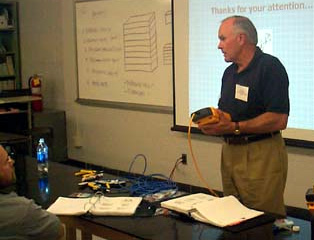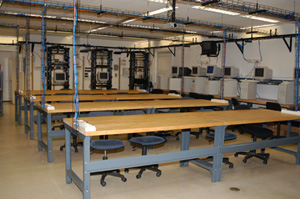Calit2 Partners with Cuyamaca College's Institute for Telecommunications Technologies
|
10.17.03 - Flush from the recent award of a large NSF grant from a very competitive program, Cuyamaca College’s Institute for Telecommunications Technologies has become the first community college to partner with Calit². This Advanced Technological Education grant – one of 22 selected from 600 submitted – awards nearly $900,000 over three years to PI Ted Chandler and co-PI Connie Elder, both faculty members in Cuyamaca’s Computer and Information Science department. “I guess superscript-itis must be catching,” says Chandler with a laugh, “because we’re becoming known already as I(T)²,” alluding to the similarity with Calit²’s acronym.
The grant will support development of telecommunications curriculum, multimedia and Web-based curriculum delivery, a “hands-on/engaged” teaching and learning laboratory, high school teacher training, and implementation of strategies to retain women in information technology and telecommunications. Their program will focus on the latest technological advances in telecommunications, particularly wireless, fiber optics, network security, high-speed networks (with an OC-48 connection already under discussion to SDSU), and convergence technologies that merge voice, video, and data applications on a single (IP-based) network.
“In one class, for example,” says Chandler, “we’ll ask students literally to respond to a request for proposals as they might be asked to do in the 'real world.' Then they’ll have to design, price, and bid construction of their networks; defend their bids; then build their networks and subject them to the rigors of Telecommunications Industry Association standards testing.”
Co-PI Elder has particular interest in the issue of retaining women in technical disciplines. “Right now only about 17% of our students in computer hardware and networking courses are women,” says co-PI Elder. “Through this grant, we hope to increase this number significantly by helping women understand it’s ok to be a nerd.”
This grant will spur plans for development of a new program in Telecommunications Networking Technology offering several professional certificates as well as an A.S. degree. This program will prepare students with technical and management skills to enter careers in design, application, installation, management, operation, and/or maintenance of computer and telecommunications networking systems. Jobs for which they will be trained for will include research, design, field service, and technical support for telephone companies, low-voltage cable installers, Internet service providers, cable and wireless communications companies, and communications equipment manufacturers. Another key goal of the program is to produce students who are qualified to enter four-year university programs, such as SDSU’s new major in Engineering and Telecommunications and UCSD’s Jacobs School of Engineering. Initial courses will be offered this spring in anticipation of formal approval of the program to start in the fall.
|
"Education and certification in a particular specialty are fine,” says Chandler. “But students also need practical experience. And, ideally, they should also get mentoring from academic and industrial professionals. These are all areas where it makes absolute sense to partner with Calit². We’re delighted to have this opportunity.” Cuyamaca students will find practical experience (for credit in their program) in Calit² living lab projects. “Moreover, through such first-hand experience of the university in a safe environment,” says Chandler, “we expect our students to think much more seriously about pursuing a B.S. or B.A. degree than they might have otherwise.”
Chandler points to the “2+2+2 educational pathway,” which is believed to help ensure student success. The idea is that students gain two years of preliminary experience in high school, such as at Cuyamaca’s partner Grossmont Union High School District, then pursue two years of technical training in a community college leading to certification in a range of specialties or an A.S. degree. Then, through practical experience at UCSD or SDSU, gain sufficient technical skills and confidence to transfer to a four-year university degree. As many as 30% of their students currently go on to such programs.
“This pathway periodically rewards students for their successes and provides them a roadmap with various options to guide them for the foreseeable future,” says Chandler. “It also provides skills that are badly needed by industry. We have some 50 companies locally that are eager to hire our graduates.”
All these plans and success stories are supported by a longer-range master plan at Cuyamaca, which will take the college to the year 2015 when it expects to be serving some 15,000 students, more than double the number it serves today. An early part of that plan is a new Science and Technology Mall, likely to house I(T)², which will include a 60,000-square foot building slated for occupancy in 2005.
For more information, see http://www.cuyamaca.net/.



